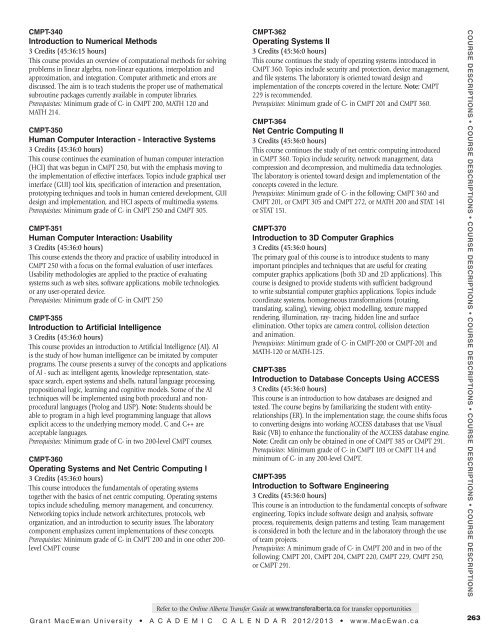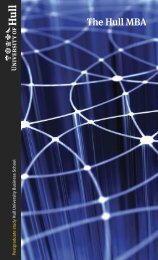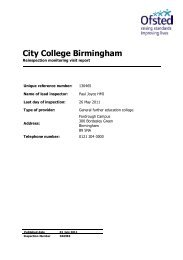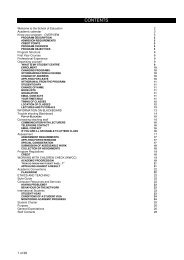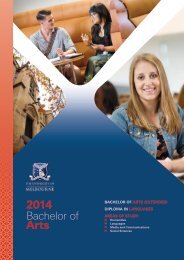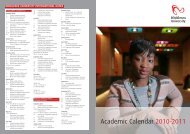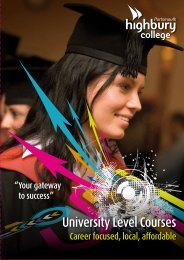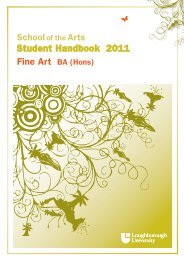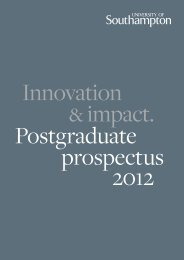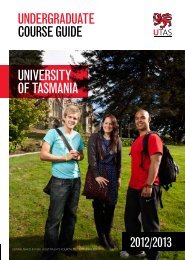Academic Calendar 2012/2013
Academic Calendar 2012/2013
Academic Calendar 2012/2013
You also want an ePaper? Increase the reach of your titles
YUMPU automatically turns print PDFs into web optimized ePapers that Google loves.
CMPT-340Introduction to Numerical Methods3 Credits (45:36:15 hours)This course provides an overview of computational methods for solvingproblems in linear algebra, non-linear equations, interpolation andapproximation, and integration. Computer arithmetic and errors arediscussed. The aim is to teach students the proper use of mathematicalsubroutine packages currently available in computer libraries.Prerequisites: Minimum grade of C- in CMPT 200, MATH 120 andMATH 214.CMPT-350Human Computer Interaction - Interactive Systems3 Credits (45:36:0 hours)This course continues the examination of human computer interaction(HCI) that was begun in CMPT 250, but with the emphasis moving tothe implementation of effective interfaces. Topics include graphical userinterface (GUI) tool kits, specification of interaction and presentation,prototyping techniques and tools in human centered development, GUIdesign and implementation, and HCI aspects of multimedia systems.Prerequisites: Minimum grade of C- in CMPT 250 and CMPT 305.CMPT-351Human Computer Interaction: Usability3 Credits (45:36:0 hours)This course extends the theory and practice of usability introduced inCMPT 250 with a focus on the formal evaluation of user interfaces.Usability methodologies are applied to the practice of evaluatingsystems such as web sites, software applications, mobile technologies,or any user-operated device.Prerequisites: Minimum grade of C- in CMPT 250CMPT-355Introduction to Artificial Intelligence3 Credits (45:36:0 hours)This course provides an introduction to Artificial Intelligence (AI). AIis the study of how human intelligence can be imitated by computerprograms. The course presents a survey of the concepts and applicationsof AI - such as: intelligent agents, knowledge representation, statespacesearch, expert systems and shells, natural language processing,propositional logic, learning and cognitive models. Some of the AItechniques will be implemented using both procedural and nonprocedurallanguages (Prolog and LISP). Note: Students should beable to program in a high level programming language that allowsexplicit access to the underlying memory model. C and C++ areacceptable languages.Prerequisites: Minimum grade of C- in two 200-level CMPT courses.CMPT-360Operating Systems and Net Centric Computing I3 Credits (45:36:0 hours)This course introduces the fundamentals of operating systemstogether with the basics of net centric computing. Operating systemstopics include scheduling, memory management, and concurrency.Networking topics include network architectures, protocols, weborganization, and an introduction to security issues. The laboratorycomponent emphasizes current implementations of these concepts.Prerequisites: Minimum grade of C- in CMPT 200 and in one other 200-level CMPT courseCMPT-362Operating Systems II3 Credits (45:36:0 hours)This course continues the study of operating systems introduced inCMPT 360. Topics include security and protection, device management,and file systems. The laboratory is oriented toward design andimplementation of the concepts covered in the lecture. Note: CMPT229 is recommended.Prerequisites: Minimum grade of C- in CMPT 201 and CMPT 360.CMPT-364Net Centric Computing II3 Credits (45:36:0 hours)This course continues the study of net centric computing introducedin CMPT 360. Topics include security, network management, datacompression and decompression, and multimedia data technologies.The laboratory is oriented toward design and implementation of theconcepts covered in the lecture.Prerequisites: Minimum grade of C- in the following: CMPT 360 andCMPT 201, or CMPT 305 and CMPT 272, or MATH 200 and STAT 141or STAT 151.CMPT-370Introduction to 3D Computer Graphics3 Credits (45:36:0 hours)The primary goal of this course is to introduce students to manyimportant principles and techniques that are useful for creatingcomputer graphics applications (both 3D and 2D applications). Thiscourse is designed to provide students with sufficient backgroundto write substantial computer graphics applications. Topics includecoordinate systems, homogeneous transformations (rotating,translating, scaling), viewing, object modelling, texture mappedrendering, illumination, ray- tracing, hidden line and surfaceelimination. Other topics are camera control, collision detectionand animation.Prerequisites: Minimum grade of C- in CMPT-200 or CMPT-201 andMATH-120 or MATH-125.CMPT-385Introduction to Database Concepts Using ACCESS3 Credits (45:36:0 hours)This course is an introduction to how databases are designed andtested. The course begins by familiarizing the student with entityrelationships(ER). In the implementation stage, the course shifts focusto converting designs into working ACCESS databases that use VisualBasic (VB) to enhance the functionality of the ACCESS database engine.Note: Credit can only be obtained in one of CMPT 385 or CMPT 291.Prerequisites: Minimum grade of C- in CMPT 103 or CMPT 114 andminimum of C- in any 200-level CMPT.CMPT-395Introduction to Software Engineering3 Credits (45:36:0 hours)This course is an introduction to the fundamental concepts of softwareengineering. Topics include software design and analysis, softwareprocess, requirements, design patterns and testing. Team managementis considered in both the lecture and in the laboratory through the useof team projects.Prerequisites: A minimum grade of C- in CMPT 200 and in two of thefollowing: CMPT 201, CMPT 204, CMPT 220, CMPT 229, CMPT 250,or CMPT 291.course Descriptions • course Descriptions • course Descriptions • course Descriptions • course Descriptions • course DescriptionsGrant MacEwan University • A C A D E m I CRefer to the Online Alberta Transfer Guide at www.transferalberta.ca for transfer opportunitiesC A L E N D A R <strong>2012</strong>/<strong>2013</strong> • www.MacEwan.ca263


